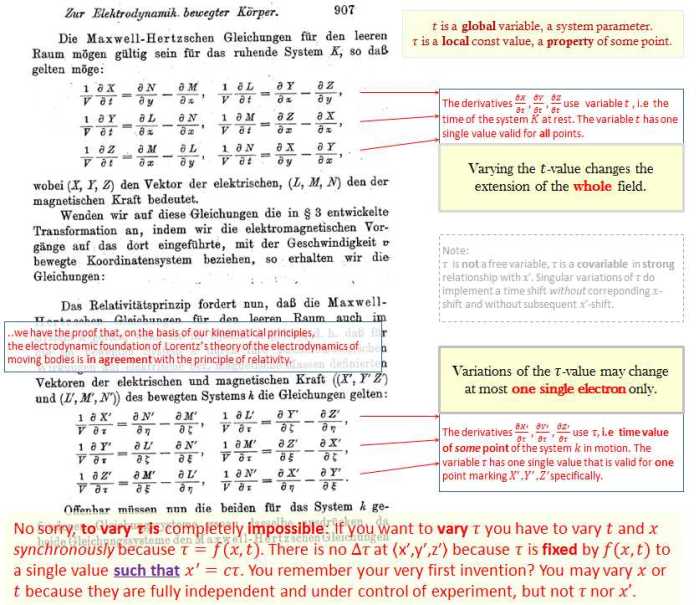If you don’t know the number of the house you have to deliver some pizza, it will be useless to establish by definition that the house in the middle of the street should be that one.
We have not defined a common “time” for A and B, for the latter cannot be defined at all unless we establish by definition that the “time” required by light to travel from A to B equals the “time” it requires to travel from B to A.
You cannot gain insights by definitions!


Let a ray of light start at the ”A time” t(A) from A towards B, let it at the ”B time” t(B) be reflected at B in the direction of A, and arrive again at A at the ”A time” t'(A). In accordance with definition the two clocks synchronize if t(B)-t(A)=t'(A)-t(B).
We assume that this definition of synchronism is free from contradictions, and possible for any number of points; and that the following relations are universally valid. In agreement with experience we further assume the quantity 2AB/(t'(A)-t(A))=c,
to be a universal constant—the velocity of light in empty space. We imagine further that at the two ends A and B of the rod, clocks are placed which synchronize with the clocks of the stationary system, that is to say that their indications correspond at any instant to the “time of the stationary system” at the places where they happen to be. These clocks are therefore “synchronous in the stationary system.” We imagine further that with each clock there is a moving observer, and that these observers apply to both clocks the criterion established in § 1 for the synchronization of two clocks. Let a ray of light depart from A at the time t(A), let it be reflected at B at the time t(B), and reach A again at the time t'(A). Taking into consideration the principle of the constancy of the velocity of light we find that t(B)-t(A)=r(AB)/(c-v) and t'(A)-t(B)=r(AB)/(c+v) where r(AB) denotes the length of the moving rod—measured in the stationary system. Observers moving with the moving rod would thus find that the two clocks were not synchronous, while observers in the stationary system would declare the clocks to be synchronous.
Vesselin Petkov argued in “Conventionality of Simultaneity and Reality” on the impossibility to determine the one-way velocity of light and the immediate implication that simultaneity is conventional.
The epistemological lesson […] demonstrates that every time when we arrive at a vicious circle some of our views should be drastically changed. And indeed the fact that the one-way velocity of light and simultaneity of distant events are conventional has turned out to have a profound meaning—reality is a four-dimensional world represented by Minkowski spacetime. There are no moving light signals or three-dimensional bodies in this four-dimensional world and when we describe it in our three-dimensional language in terms of motions, the velocities of these signals and bodies are determined by convention since they do no represent anything real.
Petkov uses a strange conception of our live and reality, based on a paper full of formal and conceptual errors. Vesselin Petkov is not alone with this conception, he seems to represent the main stream opinion of physics and philosophy:
- Our live is a material disaster,
- our knowledge is an incomplete view only and
- all around us looks and acts quite nihilistic.
But: Nobody is obliged to accept what Einstein published. We can synchronize our clocks quite precisely by using satellite signals where two receivers stay at the same distance from the sender. Clearly, no signal can ever show the time it needed to run by itself, but we can use our genius to build a GPS and to detect nonsense. The einsteinian nihilism is indeed incapable to synchronize clocks. The B-clock is given always and independent from the causal velocity the same value when the signal is coming despite the fact that this value does not represent the reality of the duration. Therefore, and this follows without knowing any details, GPS-clocks would not be able to calculate some position if they would dice the time values of their clocks – like Einstein wanted.




We don’t find some active teacher at a German high school or German university that is critical about Einstein’s ideas and does state this publicly. Why?